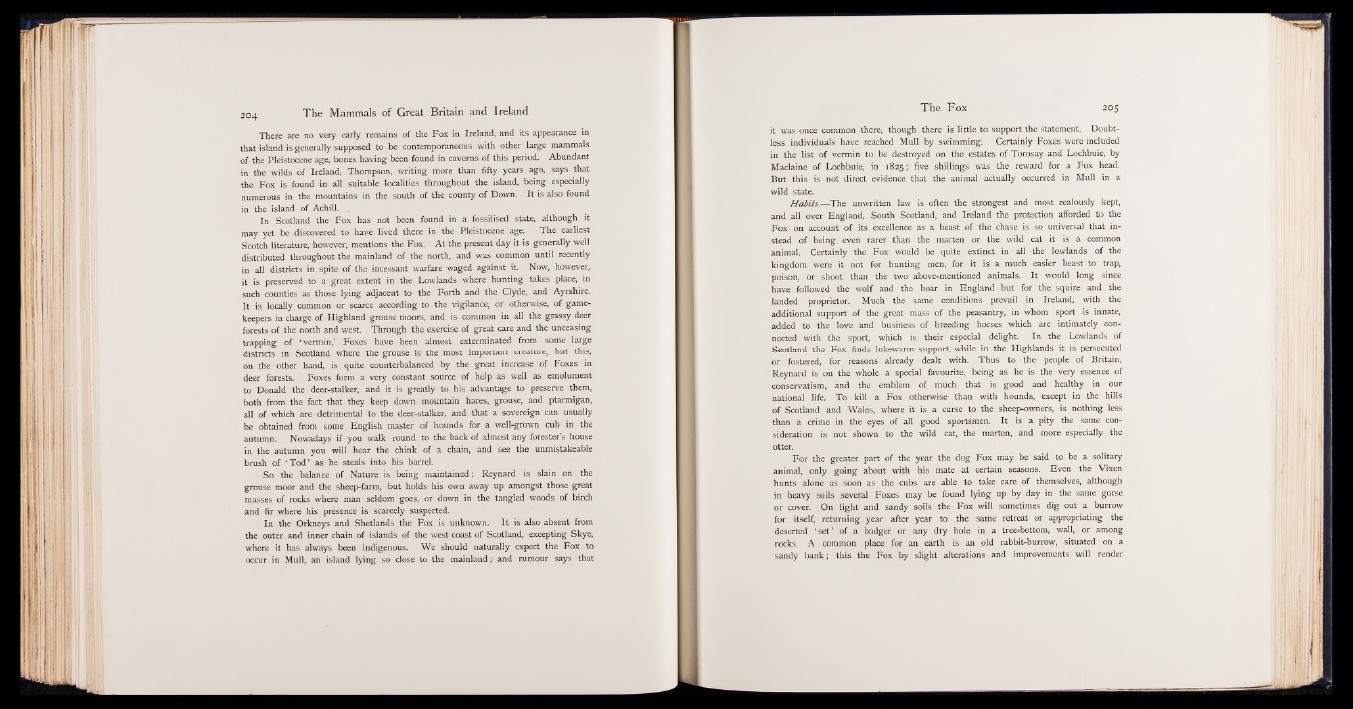
There are no very early remains of the Fox in Ireland, and its appearance in
that island is generally supposed to be contemporaneous with other large mammals
of the Pleistocene age, bones having been found in caverns of this period. Abundant
in the wilds of Ireland, Thompson, writing more than fifty years ago, says that
the Fox is found in all suitable localities throughout the island, being especially
numerous in the mountains in the south of the county of Down. It is also found
in the island of AchilL ;
In Scotland the Fox has not been found in a fossilised state, although it
may yet be discovered to have lived there in the Pleistocene age. The earliest
Scotch literature, however, mentions the Fox. At the present day it is generally well
distributed throughout the mainland of the north, and was common until recently
in all districts in spite of the incessant warfare waged against it. Now, however,
it is preserved to a great extent in the Lowlands where hunting takes place, in
such counties as those lying adjacent to the Forth and the Clyde, and Ayrshire.
It is locally common or scarce according to the vigilance, or otherwise, of game-
keepers in charge of Highland grouse moors, and is common in all the grassy deer
forests of the north and west. Through the exercise of great care and the unceasing
trapping of -vermin,’ Foxes have been almost exterminated from some large
districts in Scotland where the grouse , is the most important creature, but this,
on the other hand, is quite counterbalanced by the great increase of Foxes in
deer forests. Foxes form a very constant source of help as well as emolument
to Donald the deer-stalker, and it is greatly to his advantage to preserve them,
both from the fact that they keep down mountain hares, grouse, and ptarmigan,
all of which are detrimental to the deer-stalker, and that a sovereign can usually
be obtained from some English master of hounds for a well-grown cub in the
autumn. Nowadays if you walk round to the back of almost any forester’s house
in the autumn you will hear the chink of a chain, and see the unmistakeable
brush of * Tod ’ as he steals into his barrel.
So the balance of Nature is being maintained: Reynard is slain on the
grouse moor and the sheep-farm, but holds his own away up amongst those great
masses of rocks where man seldom goes, or down in the tangled woods of birch
and fir where his presence is scarcely suspected.
In the Orkneys and Shetlands the Fox is unknown. It is also absent from
the outer and inner chain of islands of the west coast of Scotland, excepting Skye,
where it has always been indigenous. We should naturally expect the Fox to
occur in Mull, an island lying so close to the mainland; and rumour says that
it was once common there, though there is^Iittle to support the statement. Doubtless
individuals have reached Mull by swimming. Certainly Foxes were included
in the list of vermin to be destroyed on the estates of Torosay and Lochbuie, by
Maclaine of Lochbuie, in 1825; five shillings was the reward for a Fox head.
But this is not direct evidence that the animal actually occurred in Mull in a
wild state.
Habits.— The unwritten law is often the strongest and most zealously kept,
and all over England, South Scotland, and Ireland the protection afforded to the
Fox on account of its excellence as a beast of the chase is so universal that instead
of being even rarer than the marten or the wild cat it is a common
animal. Certainly the Fox would be quite extinct in all the lowlands of the
kingdom were it not for hunting men, for it is a much easier beast to trap,
poison, or shoot than the two above-mentioned animals. It would long since
have followed the wolf and the boar in England but for the squire and the
landed proprietor. Much the same conditions prevail in Ireland, with the
additional support of the great mass of the peasantry, in whom sport is innate,
added to the love and business of breeding horses which are intimately connected
with the sport, which is their especial delight. In the Lowlands of
Scotland the Fox finds lukewarm support, while in the Highlands it is persecuted
or fostered, for reasons already dealt with. Thus to the people of Britain,
Reynard is on the whole a special favourite, being as he is the very essence of
conservatism, and the emblem of much that is good and healthy in our
national life. To kill a Fox otherwise than with hounds, except in the hills
of Scotland and Wales, where it is a curse to the sheep-owners, is nothing less
than a crime in the eyes of all good sportsmen. It is a pity the same consideration
is not shown to the wild cat, the marten, and more especially the
otter.
For the greater part of the year the dog Fox may be said to be a solitary
animal, only going about with his mate at certain seasons. Even the Vixen
hunts alone as soon as the cubs are able to take care of themselves, although
in heavy soils several Foxes may be found lying up by day in the same gorse
or cover. On light and sandy soils the Fox will sometimes dig out a burrow
for itself, returning year after year to the same retreat or appropriating the
deserted ‘ set’ of a badger or any dry hole in a tree-bottom, wall, or among
rocks. A common place for an earth is an old rabbit-burrow, situated on a
sandy bank; this the Fox by slight alterations and improvements will render